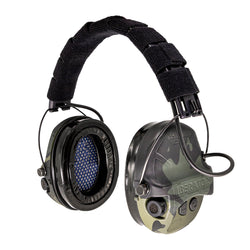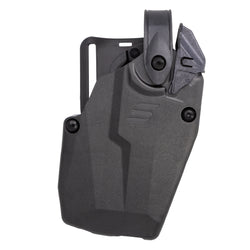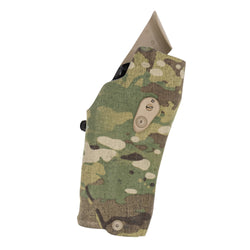Shooters are taught muzzle discipline from the very beginning. It’s one of the Four Basic Rules of Firearm Safety: “Do not point your gun at anything you’re not willing to destroy.” Shirking that rule will draw disapproving stares, stern correction, or even get you booted from the range.

But muzzle discipline on the range is very different from the real world. In the video below, Safariland CADRE Rich Graham explains the importance of muzzle discipline in a 360-degree environment and shows us a drill to develop our peripheral vision to implement it properly.
A real-world scenario will likely involve other people all around you. So, there’s no such thing as keeping your muzzle pointed downrange. Proper muzzle discipline in that environment requires awareness not only of your target, but also of all the people in your immediate vicinity, including those behind the threat.

Muzzle Discipline and Line to Target
Graham begins by discussing how to establish the line toward the target. If a threat presents itself in a populated environment, you can’t just bring up your gun and swing it to meet that threat. You have to determine the best line to the threat and either move to an open lane, move people out of your way, or both. But since this is an individual drill on a range, and dummies can’t move, you’re required to move, which isn’t necessarily a bad thing.
Moving while keeping your eyes on the threat develops your peripheral vision while also training you to keep the muzzle pointed in a safe direction. A 360-degree environment means you can point the gun up or down until you present to the target. That’s it. But there are different methods for up and down.

High and Low Muzzle Discipline
Graham identifies four basic ready positions: high port and high ready, and low port and low ready. Most of us are familiar with low ready and high ready, but Graham breaks down some fundamentals of each. Watch the video for those.
He also shows us high port and low port, which are essentially pointing the muzzle straight up or straight down. Those are really the only safe ways to do it when surrounded by bystanders. High port and low port allow you to transition to high ready and low ready, or through those positions to the presentation. Again, watch the video for the all-important fundamentals.

There’s more to that than you might think. Important factors like wrist position, elbow position, and whether you’re bending over combine to determine whether these positions are indeed safe or if you’re inadvertently flagging an innocent as you move. Graham makes an important point about that, saying your torso should act as a gimbal to keep you properly oriented, with shoulders, arms, legs, and head moving as needed. Watch the video for a demonstration.
360-Degree Muzzle Discipline Drills
Graham uses dummy targets to demonstrate a couple of drills that teach you to determine the line to the threat, while also not flagging people who might be in the way. The first lines up the dummies laterally, requiring you to move back and forth while presenting your firearm toward the target or moving to a ready or port position when that line is blocked.

The second stacks the dummies in a file, with the target in the rear. The dummies should be staggered slightly to force you to identify your best line to the threat from the beginning. Graham is left-handed, but his first move in the demonstration goes right because it establishes his line more quickly.
The drill progresses by moving forward and weaving in and out of the dummies, perhaps even circling them, while keeping your eyes on the threat. The dummies are identified and catalogued using your peripheral vision. Peripheral vision can be trained, and this drill will help do that. As before, proper muzzle discipline must be exercised when crossing a dummy’s face.

Graham notes that some ranges won’t allow drills like this, so he emphasizes that it can be done using dry fire. In fact, his demonstrations are all dry fire. One run through the stacked dummies doesn’t even employ a firearm. He just simulates holding a gun.
The point is to train your eyes and your muzzle discipline. It doesn’t have to be a shooting drill. You could do this in your garage or backyard and get positive results.

Not Exactly the Real World
Graham says that a real-world incident probably won’t go down exactly like this drill. People don’t just stand still. You’ll be moving right along with them or, more likely, against them. The real thing will likely include you moving people out of the way or telling them to move. But the point is training your vision to identify and deal with those people while staying focused on the threat.

This is clearly a beneficial drill that addresses components of a real-life situation that many of us probably don’t train for. A static range with a hard firing line doesn’t do this, but you can do it yourself with very little effort. You don’t need a range. But you’ll develop valuable skills that will help you navigate your environment if the worst happens. Check out the video for more details.









